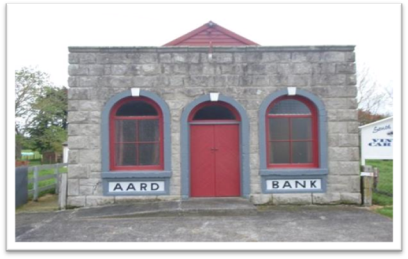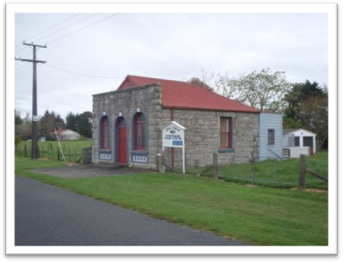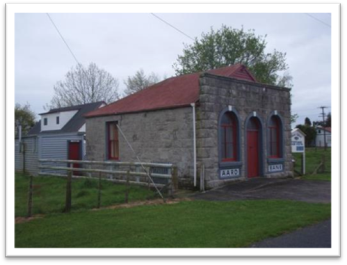HH-07: Vintage Car Club Building

Date of Photograph: 16/10/2008
Location and Zoning Information | |
Address |
6 Pepperill Rd, Lichfield |
Current Owner |
South Waikato District Council |
Legal Description |
Lot 474 DP 334 XV Patetere North SD |
Zoning |
General Rural Zone |
Valuation Number |
0541309200 |
Google Maps Link |
|
Architecture | |
Date of Construction |
1885 - 1888 |
Materials |
Local rock walls with corrugated iron roof. More recent lean-to attachment at rear in timber. Lichfield Stone - Putaruru Ignimbrite (quarried from outcrop on nearby Rea's farm)(HNZPT). |
Architecture/Engineer/Builder |
Unknown |
Condition |
Excellent condition. Date of wooden additions not known. Renovated after 1995, kitchen added and roof replaced (HNZPT). |
Original Site Recommendation |
HNZPT Ref: 2689. Heritage Advisor, HNZPT |
Current Use |
Vintage Car Club recreation room |
Statement of Significance |
(1 Historical) - aspect of history, constructed in 1885 for Mr Heany; history of continued use for commercial and community functions, currently clubrooms. Dates from early periods of settlement in South Waikato. (3 Community Association) - has important community association and public esteem, store, church (Interdenominational Church Soc. Presbyterian, Methodist, Anglican), referred to as a bank but never used as a bank, local landmark. (6 Educational) - has potential to educate public about history of South Waikato, heritage trail/school programme, potential to educate the public about the history of South Waikato and early Lichfield. (7 Archaeology pre 1900) - site can be investigated using archaeological methods to obtain information concerning NZ and South Waikato history. (10 Architectural) - is an important example of construction using particular material, example of construction of a building from quarried volcanic Ignimbrite (quarried at Rea's farm). Exterior visual aspects: facade is a strong visual element, writing on facade had people believe the building was once a bank, openings (windows/doorway) fanlights etc. support the visual character of the facade. Visual aspects to consider that relate to history, community association, architecture and integrity - façade, construction materials landscape. (13 Integrity) - has a good level of integrity, the building has had few alterations and is in good condition. District Plan RulesDemolition - DIS. Protection focus - 1,3, 6, 7 and 10. Mitigate the effects of demolition by requiring the applicant to provide Historical Building Documentation (HBD) which should include: the structure history, photographic documentation and measurements of the item prior to removal. Alterations necessary for the primary purpose of improving structural performance, fire safety or physical access – CON -Refer to HH-R2. Other Additions/Alterations - DIS. Protection focus - 6, 10, 13 and stone. Effects can be mitigated/remedied through; a) HBD - See mitigating the effects of demolition. b) Design Rules: 1.The overall visual character/shape of the original building should be identifiable. The addition should not dominate the existing building. 2. New work should be restricted to the rear of the building and not be evident from the road frontage. 3. The following special elements that are associated with the rarity or architectural uniqueness or craftsmanship of the structure should be retained: Elements of the structure that should be retained are those elements associated with its historic use as a rare type of building, i.e. façade, exterior walls, openings, landscape and any other elements identified in the Historic Building Documentation. c) Building materials rule: If the repair of the buildings is proposed the materials used for the exterior walls should be similar in type, dimensions and profile as the existing exterior fabric of the building. Repair of the Structure - PER. Refer to HH-R1. Protection focus - 3, 6, 10, 13 and stone. Discretionary - stone. Building Materials Rule: If repair of the buildings is proposed the materials used for the exterior walls and elements should be similar in type, dimensions and profile as the existing exterior fabric of the building. Design Rule: Repair and replication work should match the existing design and profile of element. The window and door surround frames should be retained and be repaired with the materials that match the existing fabric. The windows should be repaired or replicated to retain the historic four-light configuration. The words under the window "AARD" and "BANK" should be retained. Re-use/Change of Use - PER. Refer to HH-R1 Protection focus - 1, 3, 6 and 13. Internal Changes - DIS. Relocation - DIS. Protection focus - 1, 13. Disturbance of the site surface/earthworks - Protection focus - 7. Note: Any place that was associated with human activity prior to 1900 and is able to provide evidence relating to the history of New Zealand is an 'archaeological site' (refer to definition of 'archaeological site' in Section 2 of the Heritage New Zealand Pouhere Taonga Act 2014). All archaeological sites are protected under the Heritage New Zealand Pouhere Taonga Act 2014 and approval from Heritage New Zealand must be obtained prior to destroying, damaging or modifying any site. Accordingly, where this site on which a building is located is an 'archaeological site' and the building is to be repaired, added to, relocated or demolished and this involves disturbance to the surface and/or subsurface of the site, approval from Heritage New Zealand is required.
|
History |
The oldest building known constructed of local rock; known as Hinuera or Putāruru stone. The building is often cited as an example of the durability of the local rock because weathering is so slight that the tool marks of workmen on the stone are still clearly visible. Is of historical interest because of its age and of particular interest to builders and architects. Building constructed behind a hotel on Penridge Street in 1885 from Lichfield stone for Mr Heaney by two stonemasons owing him a debt for their lodgings. The building was initially used as a billiard room then a general store and bank and then as a residence, until it was renovated and dedicated as a church in 1946. Words AARD BANK on front of structure however historical data notes structure has never been used as a bank - further research needed to establish origin and significance of these words. It is currently used as a clubrooms for the Tokoroa Vintage Car Club. Bush in area now cleared and replaced by farm land. Timber mills moved elsewhere. (HNZPT). |
Additional Photographs

